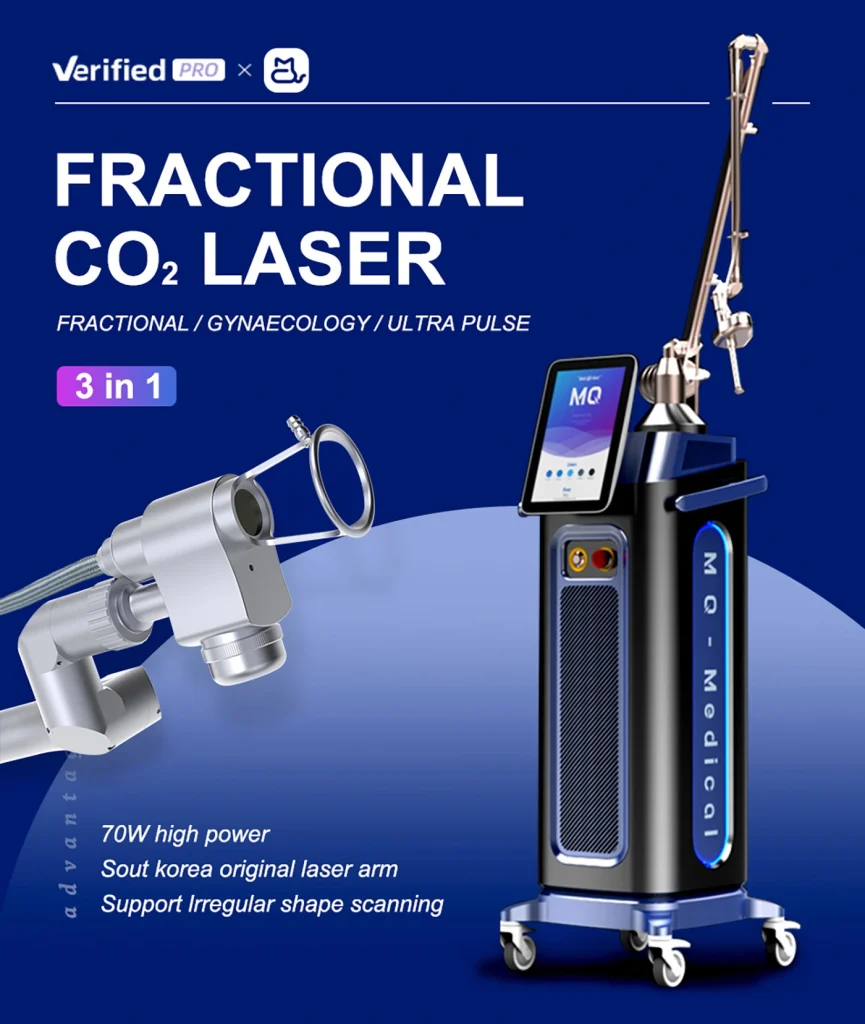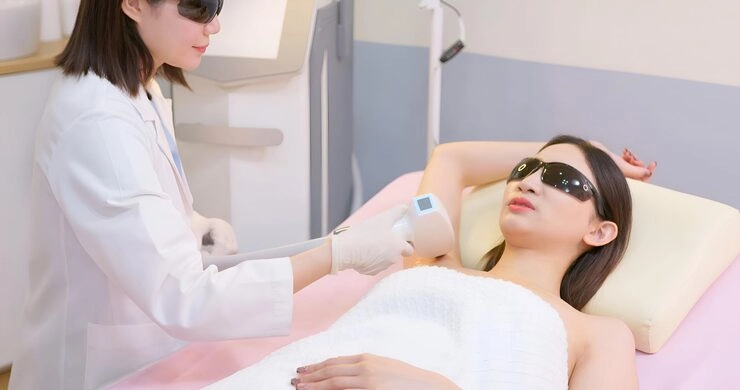
Fractional CO₂ lasers are widely praised for their ability to refresh skin, smooth wrinkles, and fade scars. But are they safe and helpful for darker skin tones? This question matters a lot. Beauty salons are now serving a wider range of clients. They need clear answers to offer safe, effective treatments.
Why Beauty Salons Are Asking the Right Questions Now
Salons are becoming more inclusive. They’re rethinking how treatments like fractional CO₂ lasers work on skin with more pigment. Getting it right can transform skin beautifully. Getting it wrong? That risks dark spots or scars. So, salons must stay informed.
How Fractional CO₂ Laser Works on the Skin
To know if this treatment suits darker skin, let’s first explore how it functions. It’s simpler than it sounds.

The Basics of Fractional Laser Energy Distribution
A fractional CO₂ laser shoots a beam that splits into many tiny rays. These rays target small spots on the skin, leaving healthy areas untouched. This method speeds up healing. It’s precise and clever.
What Happens Beneath the Surface During Treatment
The laser’s heat dives deep into the treated spots. It creates controlled damage, which sounds scary but isn’t. This triggers the skin to make new collagen, a protein that keeps skin firm and youthful. As the skin heals itself, it produces lots of collagen. The result? Smoother, healthier skin. It looks younger, too.
Key Features of Modern CO₂ Laser Devices
Today’s machines are advanced. They have settings you can tweak and patterns for different goals. A colorful screen guides users step by step. Plus, a flexible arm rotates fully, making treatments painless and accurate. These tools are built for precision.
Challenges Faced by Darker Skin Tones in Laser Treatments
Darker skin needs extra care with light-based treatments. Let’s see why.
The Role of Melanin in Light-Based Procedures
Melanin, the pigment in darker skin, soaks up light energy quickly. This can cause problems. Too much heat might harm the skin. Salons need to be cautious.
Potential Risks: Hyperpigmentation, Discoloration, and Texture Changes
If settings aren’t right, darker skin might develop dark spots, light patches, or uneven texture. Scarring is another worry. These risks are higher with older lasers that deliver strong heat. That’s why care is crucial.
Why Traditional CO₂ Lasers Raise Concerns for Darker Skin
Older CO₂ lasers aren’t selective. They can damage healthy tissue, raising the chance of scars. For darker skin, this is risky. Newer tech, though, changes the game.
Is Fractional CO₂ Laser Ever Suitable for Dark Skin Tones?
Yes, it can be! Modern advancements make it safer for all skin types, including darker ones, when done right.
Advancements That Make a Difference in Safety

UltraPulse and SuperPulse Modes Explained Simply
UltraPulse lasers send quick, powerful bursts. These short pulses control heat spread, protecting nearby skin. It’s a safer choice for darker tones. Less heat means fewer risks.
Smart Spot Technology and Spiral Patterns for Controlled Energy Delivery
New systems use patterns like spirals to spread energy evenly. This avoids hot spots that could cause dark spots. Besides, the laser points are spaced out carefully. This keeps treatments uniform and safe.
Importance of Custom Settings and Operator Skill
Even the best machines need skilled hands. Operators must adjust settings like pulse length and spot size for each client. This customization is key. It lowers risks and boosts results.
Best Practices for Safe Use on Darker Skin Tones
To treat darker skin safely, salons must follow strict steps before and during sessions.
Pre-Treatment Evaluation Tips for Beauty Professionals
Importance of a Comprehensive Skin Type Classification Beyond Clinical Scales
Don’t just use standard skin type charts. Look at a client’s sun exposure, scarring habits, and medications. Some drugs make skin sensitive to light. A thorough check ensures safety.
Setting Realistic Expectations with Clients
Be honest with clients. Explain risks and recovery times clearly. This builds trust. What’s more, it helps clients follow aftercare rules, which prevents problems.
Adjusting Parameters Based on Individual Needs
Energy Level, Pulse Duration, and Spot Size Considerations
Deeper treatments build up heat fast. So, use lower energy and longer gaps between pulses. Smaller spots focus heat better, avoiding spread to pigmented areas. These tweaks make a big difference.
Alternatives to CO₂ Laser for Melanin-Rich Skin Types
Sometimes, the risks of CO₂ lasers outweigh the benefits. Other options can work better.
Exploring Other Light-Based Technologies with Lower Risk Profiles
Non-ablative lasers, with wavelengths like 1320nm or 1550nm, are gentler. They don’t go as deep, so they cause less heat damage. Options that target water in the skin need more sessions but are safer. These are great for cautious clients.
How Non-Ablative Options Compare in Results and Safety
Non-ablative lasers take longer to show results. But they’re safer and have shorter recovery times. For clients worried about pigment changes, these are smart choices. Safety comes first.
MQLASER: A Trusted Partner in Aesthetic Innovation
For salons wanting reliable tools for diverse clients, MQLASER offers top-notch solutions focused on safety and results.
Who We Are and What We Offer at MQLASER
MQLASER creates high-quality beauty devices. Their machines handle scar repair, wrinkle reduction, intimate care, and pigment removal. Importantly, they work safely across all skin types.
Product Highlight: DEPPLUS® Stationary Fractional CO2 Laser

Designed with Versatility and Precision
The DEPPLUS® model uses a 10600nm wavelength for deep skin penetration. It offers three modes: fractional, normal, and vaginal. This makes it perfect for face treatments and more personal care.
Customizable Settings Tailored to Various Skin Needs
Operators can adjust settings like pulse length (0.1–9.9 ms) and spacing (0.1–2 mm). This flexibility lets salons tailor treatments to each client’s skin. Full control is in your hands.
Why Beauty Professionals Choose MQLASER
MQLASER’s machines are easy to use. They also connect to a remote system for quick error fixes. This blend of simplicity and tech ensures consistent, safe results for all clients.
Key Takeaways for Beauty Salons Working with Diverse Clientele
As more clients with darker skin seek advanced treatments, salons must adapt. Here’s how:
- Know when fractional CO₂ lasers are safe—and when they’re not.
- Educate clients fully before starting.
- Keep training and upgrade equipment to stay current.
These steps protect clients and build your salon’s reputation as a trusted, inclusive provider.
Final Thoughts: Proceed with Knowledge, Not Fear
Innovation doesn’t mean risking safety. By understanding how fractional CO₂ lasers work with darker skin and using modern tools wisely, salons can offer great results confidently. Knowledge is power.
FAQs
Q1: Can people with dark skin safely undergo fractional CO₂ laser treatments?
A: Yes! With careful evaluation and customized settings, advanced devices like those from MQLASER make it safe. Quick-pulse modes reduce heat spread, lowering risks for darker skin.
Q2: What precautions should salons take before treating dark-skinned clients?
A: Check scarring history, sun habits, and medications thoroughly. Start with gentle settings, like low energy and small spots, to test skin response. This keeps treatments safe.
Q3: Are there effective alternatives if fractional CO₂ isn’t suitable?
A: Definitely. Non-ablative lasers, like 1320nm or 1550nm, are safer options. They need more sessions but cause less heat damage. They’re ideal for avoiding pigment issues.
















